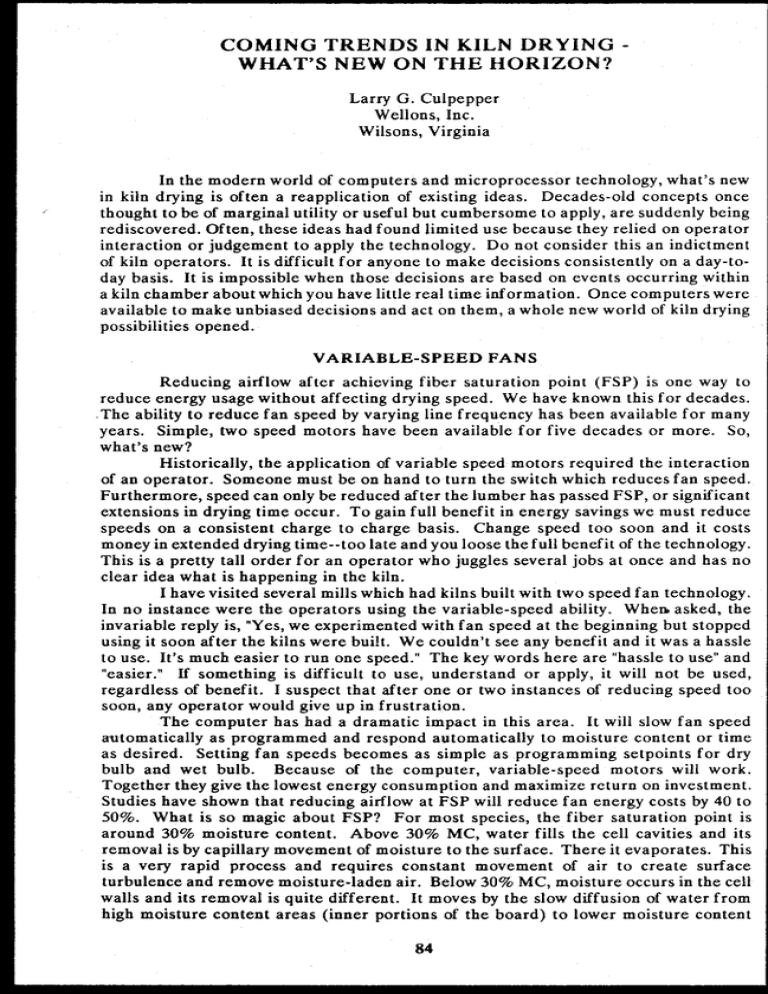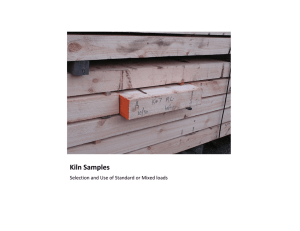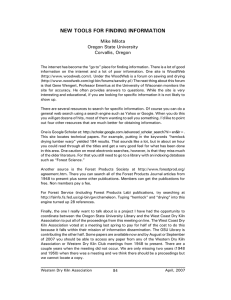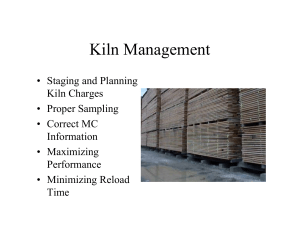COMING TRENDS IN KILN DRYING - WHAT'S NEW ON THE HORIZON?
advertisement

COMING TRENDS IN KILN DRYING WHAT'S NEW ON THE HORIZON? Larry G. Culpepper Wellons, Inc. Wilsons, Virginia In the modern world of computers and microprocessor technology, what's new in kiln drying is often a reapplication of existing ideas. Decades-old concepts once thought to be of marginal utility or useful but cumbersome to apply, are suddenly being rediscovered. Often, these ideas had found limited use because they relied on operator interaction or judgement to apply the technology. Do not consider this an indictment of kiln operators. It is difficult for anyone to make decisions consistently on a day-today basis. It is impossible when those decisions are based on events occurring within a kiln chamber about which you have little real time information. Once computers were available to make unbiased decisions and act on them, a whole new world of kiln drying possibilities opened. VARIABLE-SPEED FANS Reducing airflow after achieving fiber saturation point (FSP) is one way to reduce energy usage without affecting drying speed. We have known this for decades. The ability to reduce fan speed by varying line frequency has been available for many years. Simple, two speed motors have been available for five decades or more. So, what's new? Historically, the application of variable speed motors required the interaction of an operator. Someone must be on hand to turn the switch which reduces fan speed. Furthermore, speed can only be reduced after the lumber has passed FSP, or significant extensions in drying time occur. To gain full benefit in energy savings we must reduce speeds on a consistent charge to charge basis. Change speed too soon and it costs money in extended drying time--too late and you loose the full benefit of the technology. This is a pretty tall order for an operator who juggles several jobs at once and has no clear idea what is happening in the kiln. I have visited several mills which had kilns built with two speed fan technology. In no instance were the operators using the variable-speed ability. When> asked, the invariable reply is, "Yes, we experimented with fan speed at the beginning but stopped using it soon after the kilns were built. We couldn't see any benefit and it was a hassle to use. It's much easier to run one speed." The key words here are "hassle to use" and "easier." If something is difficult to use, understand or apply, it will not be used, regardless of benefit. I suspect that after one or two instances of reducing speed too soon, any operator would give up in frustration. The computer has had a dramatic impact in this area. It will slow fan speed automatically as programmed and respond automatically to moisture content or time as desired. Setting fan speeds becomes as simple as programming setpoints for dry bulb and wet bulb. Because of the computer, variable-speed motors will work. Together they give the lowest energy consumption and maximize return on investment. Studies have shown that reducing airflow at FSP will reduce fan energy costs by 40 to 50%. What is so magic about FSP? For most species, the fiber saturation point is around 30% moisture content. Above 30% MC, water fills the cell cavities and its removal is by capillary movement of moisture to the surface. There it evaporates. This is a very rapid process and requires constant movement of air to create surface turbulence and remove moisture-laden air. Below 30% MC, moisture occurs in the cell walls and its removal is quite different. It moves by the slow diffusion of water from high moisture content areas (inner portions of the board) to lower moisture content 84 areas (the board surface). Lower air velocities will remove this surface moisture without affecting drying speed. Computer systems which have TDAL (Temperature Drop Across the Load) moisture measurement can detect the FSP threshold and reduce fan speed automatically. The benefits do not stop here. It is now possible to maximize airflow by controlling your motors to a constant amperage. On start-up, cold, heavy, kiln air is harder to move and requires more energy. As the air heats and becomes lighter, amperage fall off by one third or more. Controlling to a set amperage allows us to reduce the initial strain of start-up and increase airflows as air becomes lighter. This allows us to maximize the potential of existing motors in those kilns requiring high air velocity. In some instances it allows us to use a smaller motor and still deliver enough air for drying. We can use the motor as a brake to quickly slow fans for faster fan reversals. Although a minor benefit, this is a more efficient use of drying time. On restart, its speed slowly increases to reduce or eliminate initial start-up power surges. This saves belts and lessens the strain on windings, bearings, and sheaves. TDAL TDAL is useful as an indicator of lumber moisture content. You may realize that it is also useful as a direct measure of energy consumption for the entire kiln. It can serve as an indicator of lumber drying rate. Many species, such as hardwoods and some western species, have slow drying rates. For them the TDAL values are low. As it happens, the TDAL value is tied very tightly to air velocity. For any species, high air velocities give low TDAL values, low air velocities give high TDAL values. To understand why, try to visualize air velocity in terms of how long air takes to travel through a stacked package of lumber. At high speeds the air moves quickly. It has less time to give up its heat than it would at slower speeds. With TDAL measuring the temperature difference across a package, it is easy to see that slow speeds result in higher TDAL values. Reducing airspeed towards charge end increases the accuracy of TDAL. What we are seeing in this example of variable speed fans is the reapplication of existing technology in the new environment of the computer...old ideas coupled with new technology giving us flexibility and tools to do a better job...opening up new potentials for kiln control far beyond expectations. FULL UTILIZATION OF COMPUTER CONTROLS When computers were first introduced to the realm of kiln control, they were designed and operated based on prevailing control concepts. There were innovations such as multizoning, exiting air heat control, and TDAL, which were themselves the application of existing technology. The actual schedule parameters, however, were set up much as they had been for decades and were very rigid to use. The evolution of these controls over the last ten years has seen a blending of ideas. This has expanded the potential for improvements. Time has seen greater flexibility built into controls, allowing the computer to make more decisions. This frees the operator to spend more of his time maximizing the efficiency of his operation. Schedules have changed. Certainly there are the familiar time and moisture driven features for controlling dry bulb and wet bulb temperatures. As mentioned, fan speeds have made their debut as a schedule parameter. Yet, with systems structured to handle any species or type of timber, more tools have become available for operator selection. It is now possible to experiment with drying techniques characteristic of species other than your own, often with remarkable improvement. We are no longer forced into control strategies dictated by someone else's concept of control. We are free to experiment with innovative schedule options and have the feedback required to make intelligent decisions. 85 Computer controls can apportion available steam when and where needed on a priority basis in times of low steam availability. Start-ups can be ramped to reduce initial boiler load. Operators can compare steam usage between charges to derive schedules which make maximum use of available energy. Ramping set-point changes lessens the impact of sudden surges in boiler demand. Steam energy management combined with fan speed control gives the capability for total energy management of the drying system. The computer gives the kiln operator the ability to fully understand what is occurring in his kiln. Rather than one temperature reading which cannot hope to reflect conditions throughout the kiln, he has many--all strategically located to give the most accurate information. They will alert him to problems as they occur, compared to later at the planing mill. He has information on moisture content on which to base decisions that affect drying rate or when to end the drying process. In addition, the ability to store and retrieve charts and information from past charges is invaluable. With it he can pinpoint and document trends or the sudden occurrence of problems. With this total view capability of past and present, computerized controls have expanded the horizon of accomplishment in any drying operation--a horizon limited only by the imagination of the most important component of any successful drying program--the kiln operator. 86



